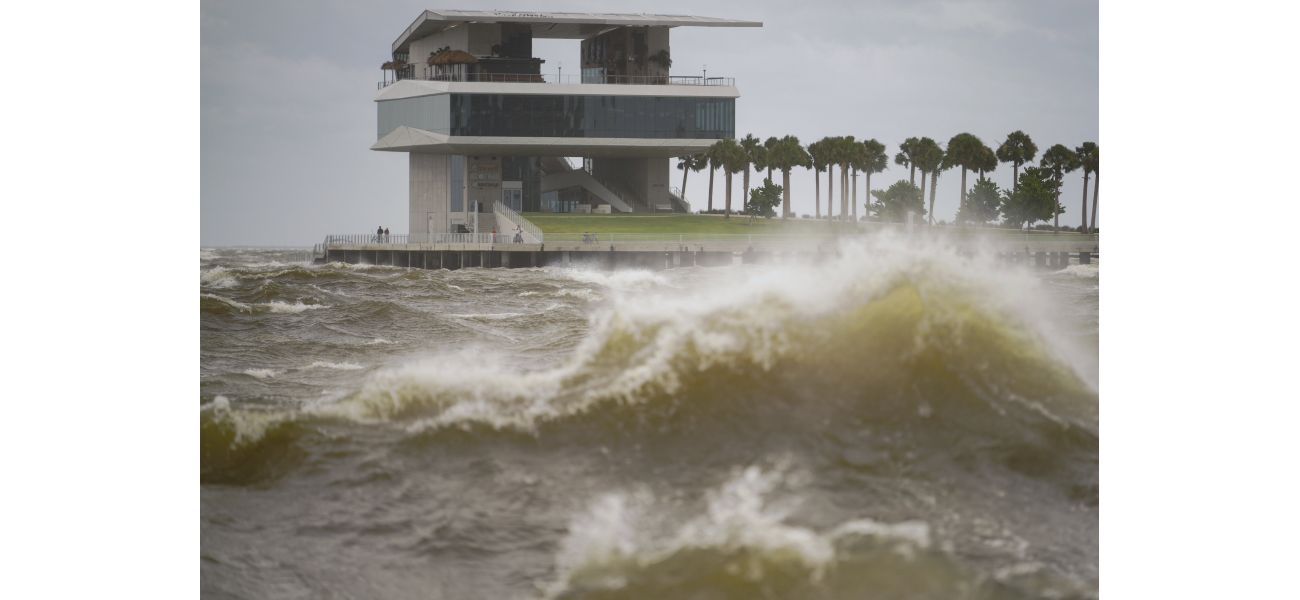Hurricane Helene arrives as a Category 4 storm in northwestern Florida.
Strong winds have caused power outages in several states, with over 250,000 properties affected.
September 27th 2024.

Hurricane Helene, a fast-moving and powerful storm, has reached the Big Bend area of Florida's northwestern coast as a Category 4 hurricane on Thursday evening. This has caused widespread concern as it poses a threat of catastrophic storm surges, damaging winds, heavy rains, and flash floods across hundreds of miles in the southeastern US.
Even before making landfall, the hurricane has already claimed two lives in Georgia due to a possible tornado and one in Florida when a sign fell onto a car driving on Interstate 4. The storm has also caused power outages to over 1 million homes and businesses in Florida and 50,000 in Georgia.
States of emergency have been declared in Florida, Georgia, the Carolinas, Virginia, and Alabama. The governor of Florida, Ron DeSantis, has urged people to stay indoors and take necessary precautions as the storm continues to advance. He also mentioned that more fatalities and destruction are expected as the hurricane makes its way through the state.
Meanwhile, in the Pacific, former Hurricane John has strengthened back into a hurricane and is threatening areas of Mexico's western coast with flash flooding and mudslides. It was downgraded to a tropical storm as it moved along the coast of the Mexican state of Michoacan.
In the Atlantic Ocean, a new tropical storm named Isaac has formed and is expected to strengthen as it moves away from the US. Forecasters predict that it may become a hurricane by the end of the week.
As the storm made landfall in northwestern Florida, it had maximum sustained winds of 140 mph and is expected to cause catastrophic flooding along the Gulf Coast. Hurricane warnings and flash flood warnings have been issued for areas far beyond the coast, including Georgia and North Carolina.
The power outages in Florida continue to rise, with over 885,000 customers without electricity as of 11 p.m. EDT. The hardest-hit areas are in Florida's Big Bend region, where the hurricane is expected to cause the most damage.
In the Pacific, John has been downgraded to a tropical storm and is moving slowly along Mexico's coast. It is still a threat, with sustained wind speeds of 70 mph, and is expected to cause severe flash flooding in coastal areas. John initially made landfall as a Category 3 hurricane in Acapulco and has since caused significant damage before weakening and reforming as a tropical storm. It is expected to continue to weaken in the coming days.
On a Thursday evening, Hurricane Helene, a fast-moving Category 4 storm, made landfall in the Big Bend area of Florida's northwestern coast. Forecasters warned of potential catastrophic storm surges, damaging winds, and flash floods that could reach hundreds of miles inland across the southeastern US.
As the storm approached, authorities in Georgia reported two deaths possibly caused by a tornado. Florida Governor Ron DeSantis also announced one fatality on Interstate 4, where a sign fell onto a passing car. The storm caused power outages for over 1 million homes and businesses in Florida and over 50,000 in Georgia, according to poweroutage.us.
States of emergency were declared in Florida, Georgia, the Carolinas, Virginia, and Alabama. Meanwhile, in the Pacific, former Hurricane John strengthened back into a hurricane as it approached Mexico's western coast. It then downgraded to a tropical storm as it moved along the coast of Michoacan. At the same time, Tropical Storm Isaac formed in the Atlantic Ocean and was expected to become a hurricane by the end of the week.
Governor DeSantis expressed concern for the safety of Floridians, stating that more fatalities were possible as the storm continued and that 3,500 National Guardsmen were prepared to assist. He urged people to stay safe and keep those affected by the storm in their thoughts and prayers.
The powerful Hurricane Helene made landfall near Perry, Florida, in the Big Bend area around 11:10 p.m. EDT with maximum sustained winds of 140 mph. The National Hurricane Center warned of potential catastrophic flooding along the Gulf Coast, particularly in Florida's Apalachee Bay.
Hurricane and flash flood warnings extended beyond the coast, reaching as far as northern Georgia and western North Carolina. As of 11 p.m. EDT, over 885,000 customers in Florida were without power, with a majority of those in the Big Bend area where Helene hit.
At the same time, former Hurricane John, which had initially hit Mexico as a Category 3 storm, was downgraded to a tropical storm as it slowly moved along the coast of Michoacan. The US National Hurricane Center reported sustained winds of 70 mph and warned of potential flash flooding in coastal areas. The storm had initially caused significant damage in Acapulco before weakening inland, reemerging over the ocean and strengthening back into a hurricane.
The hurricane center predicted that John would continue to weaken before eventually dissipating. The storm's impact on Mexico highlighted the potential dangers of hurricanes and the importance of being prepared for severe weather events.
Even before making landfall, the hurricane has already claimed two lives in Georgia due to a possible tornado and one in Florida when a sign fell onto a car driving on Interstate 4. The storm has also caused power outages to over 1 million homes and businesses in Florida and 50,000 in Georgia.
States of emergency have been declared in Florida, Georgia, the Carolinas, Virginia, and Alabama. The governor of Florida, Ron DeSantis, has urged people to stay indoors and take necessary precautions as the storm continues to advance. He also mentioned that more fatalities and destruction are expected as the hurricane makes its way through the state.
Meanwhile, in the Pacific, former Hurricane John has strengthened back into a hurricane and is threatening areas of Mexico's western coast with flash flooding and mudslides. It was downgraded to a tropical storm as it moved along the coast of the Mexican state of Michoacan.
In the Atlantic Ocean, a new tropical storm named Isaac has formed and is expected to strengthen as it moves away from the US. Forecasters predict that it may become a hurricane by the end of the week.
As the storm made landfall in northwestern Florida, it had maximum sustained winds of 140 mph and is expected to cause catastrophic flooding along the Gulf Coast. Hurricane warnings and flash flood warnings have been issued for areas far beyond the coast, including Georgia and North Carolina.
The power outages in Florida continue to rise, with over 885,000 customers without electricity as of 11 p.m. EDT. The hardest-hit areas are in Florida's Big Bend region, where the hurricane is expected to cause the most damage.
In the Pacific, John has been downgraded to a tropical storm and is moving slowly along Mexico's coast. It is still a threat, with sustained wind speeds of 70 mph, and is expected to cause severe flash flooding in coastal areas. John initially made landfall as a Category 3 hurricane in Acapulco and has since caused significant damage before weakening and reforming as a tropical storm. It is expected to continue to weaken in the coming days.
On a Thursday evening, Hurricane Helene, a fast-moving Category 4 storm, made landfall in the Big Bend area of Florida's northwestern coast. Forecasters warned of potential catastrophic storm surges, damaging winds, and flash floods that could reach hundreds of miles inland across the southeastern US.
As the storm approached, authorities in Georgia reported two deaths possibly caused by a tornado. Florida Governor Ron DeSantis also announced one fatality on Interstate 4, where a sign fell onto a passing car. The storm caused power outages for over 1 million homes and businesses in Florida and over 50,000 in Georgia, according to poweroutage.us.
States of emergency were declared in Florida, Georgia, the Carolinas, Virginia, and Alabama. Meanwhile, in the Pacific, former Hurricane John strengthened back into a hurricane as it approached Mexico's western coast. It then downgraded to a tropical storm as it moved along the coast of Michoacan. At the same time, Tropical Storm Isaac formed in the Atlantic Ocean and was expected to become a hurricane by the end of the week.
Governor DeSantis expressed concern for the safety of Floridians, stating that more fatalities were possible as the storm continued and that 3,500 National Guardsmen were prepared to assist. He urged people to stay safe and keep those affected by the storm in their thoughts and prayers.
The powerful Hurricane Helene made landfall near Perry, Florida, in the Big Bend area around 11:10 p.m. EDT with maximum sustained winds of 140 mph. The National Hurricane Center warned of potential catastrophic flooding along the Gulf Coast, particularly in Florida's Apalachee Bay.
Hurricane and flash flood warnings extended beyond the coast, reaching as far as northern Georgia and western North Carolina. As of 11 p.m. EDT, over 885,000 customers in Florida were without power, with a majority of those in the Big Bend area where Helene hit.
At the same time, former Hurricane John, which had initially hit Mexico as a Category 3 storm, was downgraded to a tropical storm as it slowly moved along the coast of Michoacan. The US National Hurricane Center reported sustained winds of 70 mph and warned of potential flash flooding in coastal areas. The storm had initially caused significant damage in Acapulco before weakening inland, reemerging over the ocean and strengthening back into a hurricane.
The hurricane center predicted that John would continue to weaken before eventually dissipating. The storm's impact on Mexico highlighted the potential dangers of hurricanes and the importance of being prepared for severe weather events.
[This article has been trending online recently and has been generated with AI. Your feed is customized.]
[Generative AI is experimental.]
0
0
Submit Comment





